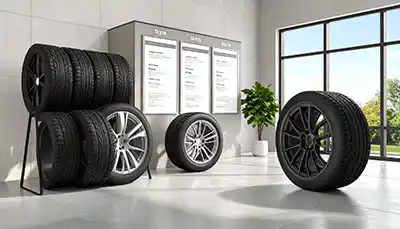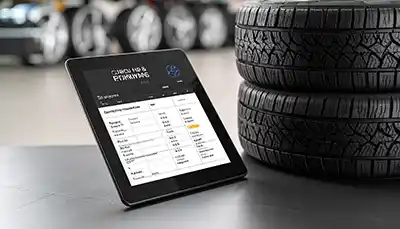Your Roadmap to Perfect Wheel & Tire Selection
Choosing the right wheels and tires is a significant decision that impacts your vehicle's performance, safety, appearance, and long-term maintenance costs. This comprehensive guide will walk you through the entire process, from understanding your needs to making the final purchase and maintaining your investment.
Guide Contents
Step 1: Assess Your Needs
Before browsing options, clearly define what you're looking for based on these factors:
- Primary Vehicle Use: Daily commuting, off-road adventures, performance driving, or a combination will significantly influence your ideal setup.
- Local Climate & Conditions: Consider seasonal weather patterns, road conditions, and whether you'll need multiple sets for different seasons.
- Performance Priorities: Determine what matters most to you—handling precision, ride comfort, fuel efficiency, noise levels, or all-terrain capability.
- Aesthetic Goals: Consider the look you want to achieve, whether subtle enhancement or dramatic transformation.
- Longevity Expectations: Balance initial cost against expected lifespan and maintenance requirements.
Take time to prioritize these factors, as they'll guide your decisions throughout the selection process.
Step 2: Understand Vehicle Specifications
Knowing your vehicle's specifications is crucial for proper fitment and performance:
- Factory Wheel & Tire Specifications: Found in your owner's manual, door jamb sticker, or through our vehicle database.
- Bolt Pattern: The number and spacing of lug holes (e.g., 5x114.3mm) must match your vehicle exactly.
- Hub Bore: The center hole diameter must be equal to or larger than your vehicle's hub diameter (hub-centric rings can adapt larger bores).
- Offset & Backspacing: These measurements determine how your wheels sit in relation to the suspension and body. Improper specifications can cause rubbing, poor handling, and premature wear.
- Load Rating: Especially important for trucks and SUVs, wheels and tires must be rated to handle your vehicle's weight plus cargo.
- TPMS Compatibility: If your vehicle has a Tire Pressure Monitoring System, ensure your new setup will work with it.
Our wheel and tire specialists can help verify these specifications for your specific vehicle make, model, and year.

Step 3: Wheel Selection Guidelines
With your needs and specifications identified, consider these factors when selecting wheels:
Wheel Size Considerations
- Diameter: Larger diameters offer improved looks and potentially better handling, but may reduce ride comfort and increase cost. Stay within 2" of factory size for best results.
- Width: Wider wheels can accommodate wider tires for improved grip but must fit within your wheel wells without rubbing.
- "Plus-Sizing": When increasing wheel diameter, you'll need to decrease tire sidewall height proportionally to maintain proper overall diameter.
Material & Construction Quality
- Cast Aluminum: Most common and affordable option, offering good performance for most drivers.
- Flow-Formed/Rotary-Forged: Hybrid manufacturing process providing enhanced strength and reduced weight over cast wheels.
- Forged Aluminum: Premium option offering maximum strength with minimum weight, ideal for performance applications.
- Steel: Durable and economical, typically used for winter wheels or off-road applications where durability trumps weight concerns.
Finish Options
- Painted: Wide range of colors with good durability when properly maintained.
- Machined: Combines painted surfaces with polished accent areas for a distinctive look.
- Polished: Mirror-like finish requiring regular maintenance to preserve appearance.
- Chrome: Highly reflective, show-quality finish that requires regular cleaning to maintain.
- Powder-Coated: Extremely durable finish available in various colors and textures.
Consider your maintenance willingness when selecting finishes—some require more care than others to maintain their appearance.
Step 4: Tire Selection Guidelines
Tires dramatically influence your vehicle's performance, safety, and comfort:
Tire Type Selection
Choose based on your driving conditions and priorities:
- All-Season: Good year-round performance in moderate climates with versatile traction in various conditions.
- Summer/Performance: Superior dry and wet grip with responsive handling, but not suitable for winter conditions.
- Winter/Snow: Specialized rubber compounds and tread patterns for superior cold-weather traction.
- All-Terrain: Balanced on-road comfort with off-road capability for SUVs and trucks.
- Mud-Terrain: Aggressive tread patterns for maximum off-road traction, with compromises in on-road comfort and noise.
- Touring: Emphasis on comfort, low noise, and tread longevity for daily drivers.
- Ultra-High Performance: Maximum grip and responsive handling for sports cars and enthusiast drivers.
Understanding Tire Ratings
- Load Index: Numeric code indicating maximum weight capacity.
- Speed Rating: Letter code designating maximum safe speed capability.
- UTQG Ratings: Government grades for treadwear, traction, and temperature resistance.
- Tread Life Warranty: Manufacturer's mileage guarantee, a useful comparison point between similar tires.
Tire Size Conversion When Changing Wheel Sizes
If you're changing wheel diameter, you'll need to adjust tire sizes accordingly:
- For each inch increase in wheel diameter, decrease sidewall height accordingly.
- Maintain overall diameter within 3% of original specifications to preserve speedometer accuracy and proper mechanical function.
- Our Tire Size Calculator can help determine the correct tire size for your new wheels.
Step 5: Wheel & Tire Packages
Consider purchasing wheels and tires as a complete package for several advantages:
- Cost Savings: Package pricing often offers better value than purchasing components separately.
- Guaranteed Compatibility: Wheels and tires are matched for proper fitment and performance.
- Mounting & Balancing Included: Professional assembly before shipping ensures proper installation.
- One-Stop Shopping: Simplifies the process by bundling all components, including necessary hardware.
- Coordinated Warranty: Single point of contact for any warranty needs.
Packages typically include wheels, tires, TPMS sensors (if applicable), lug nuts, and center caps, all professionally mounted and balanced.
Step 6: Budgeting Considerations
When planning your purchase, account for these factors in your budget:
- Initial Purchase: Quality wheels and tires represent a significant investment—generally, higher quality commands higher prices but often delivers better long-term value.
- Installation Costs: Professional mounting, balancing, and installation ensure optimal performance and safety.
- Additional Components: You may need hub-centric rings, extended lug nuts, TPMS sensors, or other hardware.
- Alignment: Often recommended after changing wheel/tire packages to ensure proper vehicle handling.
- Long-Term Value: Consider durability, warranty coverage, and expected lifespan when comparing options.
- Financing Options: We offer various payment plans to help make your upgrade more affordable.
Remember that while premium options cost more initially, they often deliver better performance, longer lifespan, and ultimately better value over time.
Step 7: Professional Installation
Proper installation is crucial for performance, safety, and longevity:
- Mounting & Balancing: Precision equipment ensures proper tire seating and optimal balance for smooth operation.
- Torque Specifications: Lug nuts must be tightened to manufacturer specifications using a calibrated torque wrench.
- TPMS Programming: If your vehicle has TPMS, sensors must be properly installed and programmed.
- Alignment Check: Ensuring proper alignment prevents premature tire wear and optimizes handling.
- Break-In Period: Drive moderately for the first 100 miles and re-torque lug nuts after this initial period.
Professional installation through Performance Plus Tire ensures all these critical steps are handled correctly.

Step 8: Maintenance Best Practices
Protect your investment with proper ongoing maintenance:
- Regular Pressure Checks: Verify pressure monthly and before long trips, adjusting to manufacturer specifications.
- Rotation Schedule: Rotate tires every 5,000-7,000 miles to promote even wear.
- Alignment Monitoring: Watch for pulling, uneven wear, or steering wheel vibration—signs of alignment issues.
- Wheel Cleaning: Regularly clean wheels with appropriate cleaners for your specific finish type.
- Seasonal Inspection: Have a professional inspect your wheels and tires before extreme weather seasons.
- Proper Storage: If using seasonal setups, store unused wheels/tires in a cool, dry place away from direct sunlight and chemicals.
Proper maintenance not only extends the life of your wheels and tires but also preserves their performance characteristics and appearance.
Key Takeaways
- Start by assessing your specific needs and understanding your vehicle's specifications.
- Balance aesthetic preferences with performance requirements when selecting wheels.
- Choose tire types based on your driving conditions, climate, and performance priorities.
- Consider wheel and tire packages for convenience, compatibility, and potential cost savings.
- Professional installation ensures safety, performance, and longevity of your new setup.
- Regular maintenance preserves your investment and maintains optimal performance.
Frequently Asked Questions
How much should I expect to spend on quality wheels and tires?
Quality wheel and tire packages typically range from $1,000 to $4,000+ depending on size, materials, performance level, and vehicle type. While premium options cost more initially, they often deliver better performance, durability, and overall value. We offer various financing options to help make your upgrade more affordable while ensuring you get quality components that will perform well and last longer.
Will changing my wheel and tire size affect my vehicle's performance?
Yes, wheel and tire changes can significantly impact performance. Larger wheels with lower-profile tires typically improve handling response and cornering grip but may reduce ride comfort. Wider wheels and tires increase traction but may affect fuel economy. Heavier wheels can negatively impact acceleration and braking. For best results, we recommend staying within 2 inches of your factory wheel diameter and maintaining your original overall tire diameter within 3%.
Do I need different wheels and tires for different seasons?
In regions with severe winter conditions (regular snow, ice, or temperatures consistently below 45°F), dedicated winter tires mounted on separate wheels are highly recommended for optimal safety. This approach also extends the life of both tire sets and simplifies seasonal changeovers. For mild climates, high-quality all-season tires may provide adequate year-round performance. Our experts can help determine the best setup based on your specific location and driving patterns.
How do I know if wheels will fit my vehicle properly?
Proper wheel fitment depends on several factors: bolt pattern, hub bore, wheel diameter, width, offset, and load rating. Using our vehicle fitment guide or consulting with our wheel specialists ensures you select wheels that fit correctly. Improper fitment can cause issues ranging from vibration and premature wear to dangerous mechanical interference. We strongly recommend professional consultation rather than guessing on these critical specifications.
What's the difference between OEM and aftermarket wheels?
OEM (Original Equipment Manufacturer) wheels are designed specifically for your vehicle model by the manufacturer. Aftermarket wheels offer more variety in designs, sizes, and performance characteristics. Quality aftermarket wheels from reputable manufacturers often feature advanced materials and construction techniques that can provide performance benefits over OEM options. However, quality varies significantly between brands, so choosing established manufacturers with proper testing and warranty support is essential.